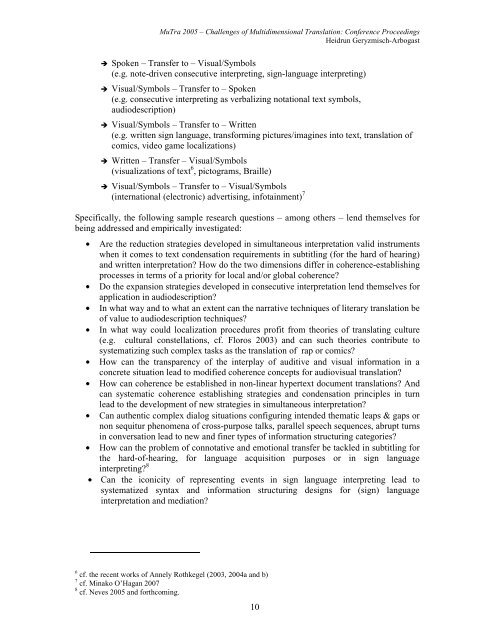Proceedings - Translation Concepts
Proceedings - Translation Concepts
Proceedings - Translation Concepts
Create successful ePaper yourself
Turn your PDF publications into a flip-book with our unique Google optimized e-Paper software.
MuTra 2005 – Challenges of Multidimensional <strong>Translation</strong>: Conference <strong>Proceedings</strong><br />
Heidrun Geryzmisch-Arbogast<br />
Spoken – Transfer to – Visual/Symbols<br />
(e.g. note-driven consecutive interpreting, sign-language interpreting)<br />
Visual/Symbols – Transfer to – Spoken<br />
(e.g. consecutive interpreting as verbalizing notational text symbols,<br />
audiodescription)<br />
Visual/Symbols – Transfer to – Written<br />
(e.g. written sign language, transforming pictures/imagines into text, translation of<br />
comics, video game localizations)<br />
Written – Transfer – Visual/Symbols<br />
(visualizations of text 6 , pictograms, Braille)<br />
Visual/Symbols – Transfer to – Visual/Symbols<br />
(international (electronic) advertising, infotainment) 7<br />
Specifically, the following sample research questions – among others – lend themselves for<br />
being addressed and empirically investigated:<br />
• Are the reduction strategies developed in simultaneous interpretation valid instruments<br />
when it comes to text condensation requirements in subtitling (for the hard of hearing)<br />
and written interpretation? How do the two dimensions differ in coherence-establishing<br />
processes in terms of a priority for local and/or global coherence?<br />
• Do the expansion strategies developed in consecutive interpretation lend themselves for<br />
application in audiodescription?<br />
• In what way and to what an extent can the narrative techniques of literary translation be<br />
of value to audiodescription techniques?<br />
• In what way could localization procedures profit from theories of translating culture<br />
(e.g. cultural constellations, cf. Floros 2003) and can such theories contribute to<br />
systematizing such complex tasks as the translation of rap or comics?<br />
• How can the transparency of the interplay of auditive and visual information in a<br />
concrete situation lead to modified coherence concepts for audiovisual translation?<br />
• How can coherence be established in non-linear hypertext document translations? And<br />
can systematic coherence establishing strategies and condensation principles in turn<br />
lead to the development of new strategies in simultaneous interpretation?<br />
• Can authentic complex dialog situations configuring intended thematic leaps & gaps or<br />
non sequitur phenomena of cross-purpose talks, parallel speech sequences, abrupt turns<br />
in conversation lead to new and finer types of information structuring categories?<br />
• How can the problem of connotative and emotional transfer be tackled in subtitling for<br />
the hard-of-hearing, for language acquisition purposes or in sign language<br />
interpreting? 8<br />
• Can the iconicity of representing events in sign language interpreting lead to<br />
systematized syntax and information structuring designs for (sign) language<br />
interpretation and mediation?<br />
6 cf. the recent works of Annely Rothkegel (2003, 2004a and b)<br />
7 cf. Minako O’Hagan 2007<br />
8 cf. Neves 2005 and forthcoming.<br />
10
















